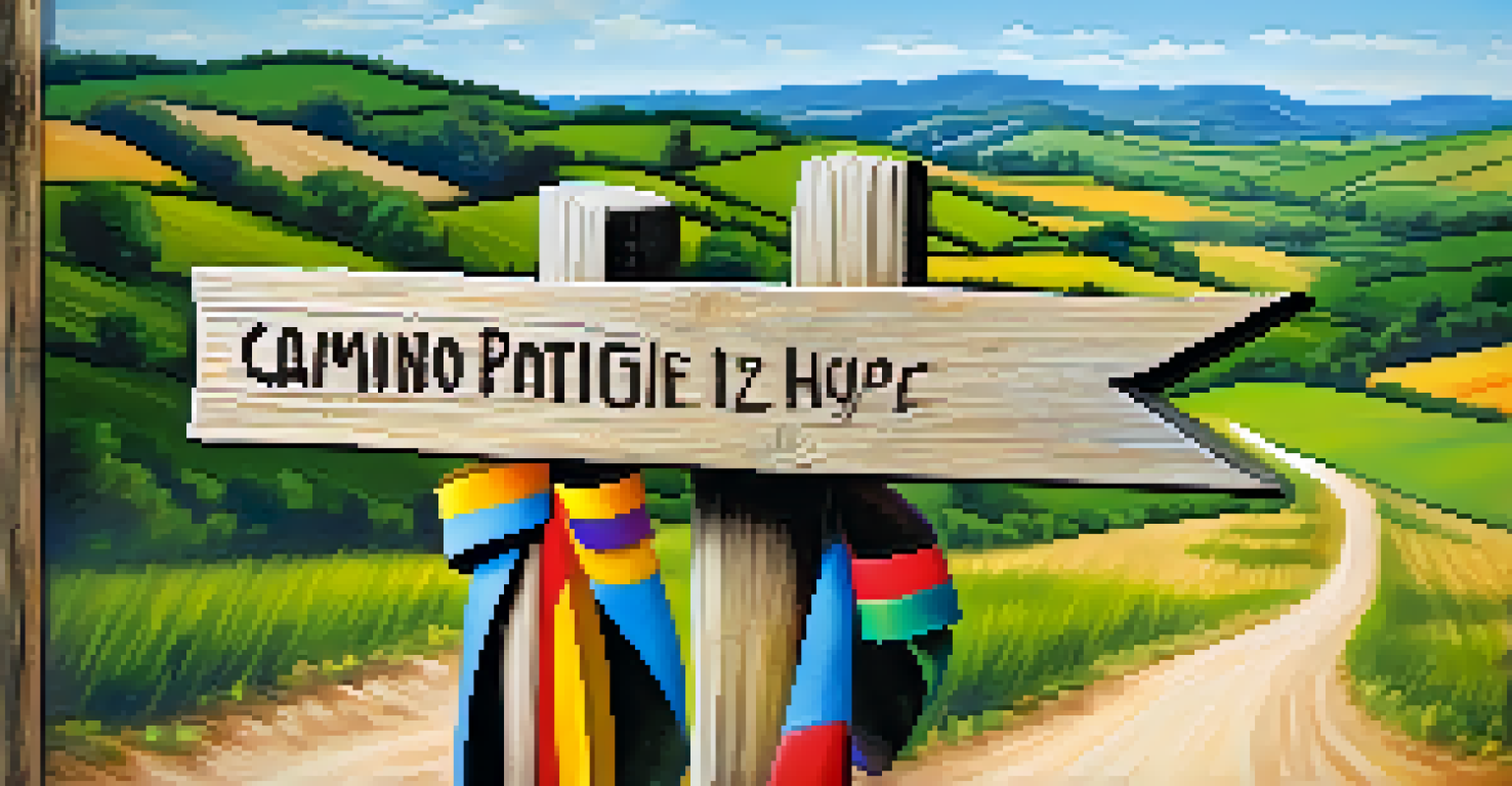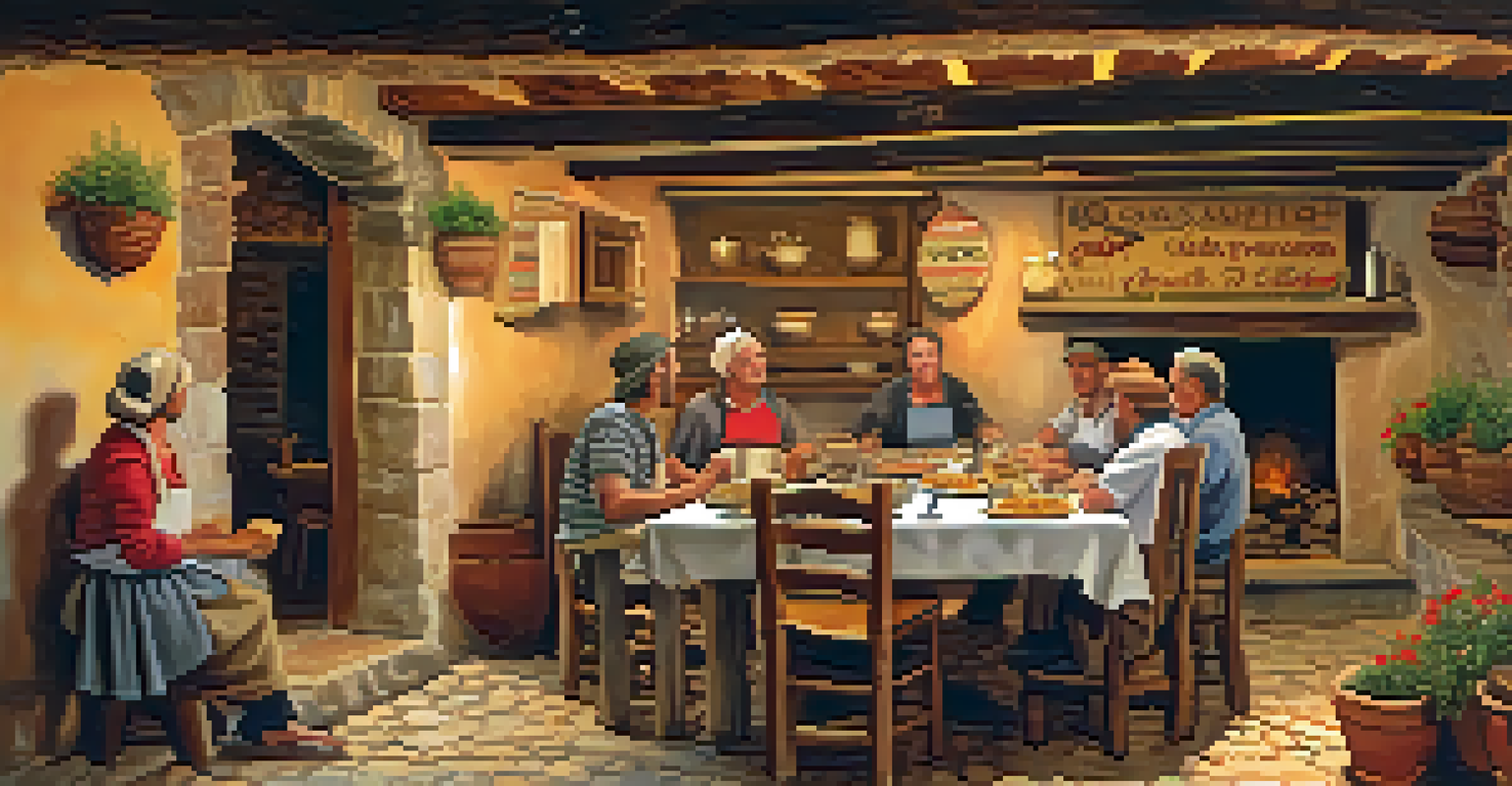The Historical Roots of Spain's Pilgrimage Routes Explained

The Origins of Pilgrimage in Spain: A Brief Overview
Pilgrimage in Spain can be traced back to ancient times when people journeyed to sacred sites for religious devotion. The most famous of these routes is the Camino de Santiago, which leads to the shrine of Saint James in Santiago de Compostela. Pilgrimages were not only acts of faith but also opportunities for personal reflection and community bonding.
The journey itself is my home.
Over the centuries, the Camino evolved, intertwining with various cultural and historical events, such as the Reconquista and the spread of Christianity. As pilgrims traveled, they brought their own stories, traditions, and even architectural styles, enriching the regions they passed through. This blending of cultures helped shape the identity of Spain as we know it today.
In essence, the pilgrimage routes became arteries of cultural exchange, allowing travelers to connect across different regions and backgrounds. The spiritual significance of these journeys was profound, fostering a sense of shared purpose that transcended geographical boundaries. Today, these historical routes continue to attract those seeking both spiritual and cultural enrichment.
The Rise of the Camino de Santiago in the Middle Ages
During the Middle Ages, the Camino de Santiago gained immense popularity, becoming one of the most important pilgrimage routes in Europe. The discovery of what were believed to be the remains of Saint James in the 9th century attracted countless pilgrims from across the continent. This led to a flourishing of towns and infrastructure along the route, providing much-needed support for travelers.

The pilgrimage was seen as a way to seek penance, healing, or even indulgences, which further motivated people to embark on the journey. Many entered the pilgrimage with the hope of spiritual renewal, while others sought to escape the hardships of daily life. These motivations showcased the diverse reasons behind why individuals undertook such formidable journeys.
Cultural Exchange Through Pilgrimage
Spain's pilgrimage routes have historically served as vital pathways for cultural exchange, enriching communities with diverse stories and traditions.
As the popularity of the Camino grew, so did its significance in the cultural and religious landscape of Spain. It became a symbol of faith, unity, and resilience, fostering connections that extended beyond borders. Even today, the Camino is a testament to this enduring legacy, inviting modern pilgrims to experience its history firsthand.
Cultural Impact of Pilgrimage Routes on Spanish Society
The pilgrimage routes have significantly influenced Spanish culture, from art to cuisine. Many artists were inspired by the stories and experiences of pilgrims, leading to an outpouring of creative expression. Churches and cathedrals built along the routes are stunning examples of Gothic and Romanesque architecture, showcasing the era's artistic achievements.
Not all those who wander are lost.
Cuisine along the Camino has also developed, with local specialties emerging to cater to weary travelers. Dishes like 'pulpo a la gallega' and 'tarta de Santiago' have become iconic, reflecting the regions they originate from. This culinary diversity not only nourishes pilgrims but also serves as a delicious reminder of the routes' cultural richness.
Moreover, the routes have fostered a sense of community among those who walk them. Pilgrims often share stories and meals, creating bonds that last long after the journey ends. This ongoing cultural exchange enriches both the individual and the community, ensuring that the spirit of the pilgrimage lives on.
Religious Significance of Pilgrimage Routes in Spain
Religious significance is at the heart of Spain's pilgrimage routes, particularly the Camino de Santiago. For many, walking the Camino is a profound spiritual experience, providing time for reflection, prayer, and a deeper connection with their faith. Each step taken along the path is viewed as a step closer to enlightenment or forgiveness.
The routes are dotted with chapels, shrines, and hostels, each offering a space for rest and contemplation. Many pilgrims pause to light candles or leave tokens of gratitude, reinforcing their spiritual journey. This sacred landscape transforms the physical act of walking into a deeply personal pilgrimage.
Spiritual Journey on the Camino
Walking the Camino de Santiago offers a profound spiritual experience, allowing pilgrims to connect deeply with their faith and seek personal reflection.
In modern times, the routes continue to draw thousands of pilgrims, both religious and non-religious, seeking solace and inspiration. Whether motivated by faith or a desire for adventure, the pilgrimage offers a unique opportunity for self-discovery and connection with others. The enduring allure of these paths speaks to their timeless spiritual significance.
Pilgrimage Routes and Their Role in Spanish National Identity
Spain's pilgrimage routes are not just historical paths; they are integral to the nation's cultural identity. The Camino de Santiago, in particular, has become a symbol of Spanish heritage, celebrated for its role in uniting diverse regions and cultures. This shared journey fosters a sense of belonging among Spaniards and visitors alike.
The routes have inspired a renewed interest in traditional practices and customs, as communities along the paths work to preserve their unique cultures. Festivals, music, and local traditions are often showcased, inviting pilgrims to engage with the rich local heritage. This celebration of culture enhances the overall pilgrimage experience.
As Spain continues to embrace its historical roots, the pilgrimage routes serve as a reminder of the resilience and unity that define the nation. Each year, thousands embark on these journeys, not only to honor the past but also to connect with the vibrant culture and community that thrives along the way. The pilgrimage is a living testament to Spain's enduring spirit.
Modern Enhancements to Pilgrimage Routes: Balancing Tradition and Progress
In recent years, the pilgrimage routes in Spain have seen modern enhancements aimed at accommodating the increasing number of pilgrims. Improvements to infrastructure, such as better signage and updated accommodations, have made the journey more accessible without compromising the authenticity of the experience. This balance between tradition and progress is essential for preserving the historical significance of the routes.
Digital tools and apps have also emerged to assist pilgrims, providing maps, tips, and even community forums. These innovations foster a sense of connection among travelers, allowing them to share their experiences and advice along the way. However, it is crucial to use technology mindfully to ensure that the essence of the pilgrimage remains intact.
Modern Challenges and Opportunities
The growing popularity of pilgrimage routes presents challenges such as overcrowding, but also opportunities for economic growth and cultural sharing within local communities.
While modern conveniences enhance the experience, many pilgrims still seek the simplicity and solitude that the traditional routes provide. The challenge lies in maintaining the spiritual and cultural integrity of these paths while welcoming a diverse range of travelers. Ultimately, the goal is to preserve the pilgrimage's historical roots while adapting to contemporary needs.
The Future of Spain's Pilgrimage Routes: Challenges and Opportunities
As the popularity of Spain's pilgrimage routes continues to grow, so too do the challenges associated with maintaining their integrity. Overcrowding can detract from the spiritual experience, leading to concerns about environmental sustainability and the preservation of local cultures. Addressing these issues will require collaboration among local communities, authorities, and pilgrims themselves.
On the other hand, the increased interest in pilgrimage offers unique opportunities for economic growth and cultural exchange. Local businesses, such as restaurants and artisan shops, thrive as they cater to the needs of travelers. This boosts the economy while allowing communities to share their heritage with a broader audience.

Looking ahead, the future of Spain's pilgrimage routes will depend on finding a balance between growth and preservation. By prioritizing sustainable practices and fostering community engagement, these historical paths can continue to inspire and connect people for generations to come. The enduring legacy of the pilgrimage is a powerful reminder of the importance of shared journeys in our lives.